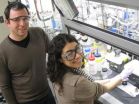(Press-News.org) PHILADELPHIA— People who try to quit smoking often say that kicking the habit makes the voice inside telling them to light up even louder, but why people succumb to those cravings so often has never been fully understood. Now, a new brain imaging study in this week's JAMA Psychiatry from scientists in Penn Medicine and the National Institute on Drug Abuse (NIDA) Intramural Research Program shows how smokers suffering from nicotine withdrawal may have more trouble shifting from a key brain network—known as default mode, when people are in a so-called "introspective" or "self-referential" state— and into a control network, the so-called executive control network, that could help exert more conscious, self-control over cravings and to focus on quitting for good.
The findings help validate a neurobiological basis behind why so many people trying to quit end up relapsing—up to 80 percent, depending on the type of treatment—and may lead to new ways to identify smokers at high risk for relapse who need more intensive smoking cessation therapy.
The brain imaging study was led by researchers at University of Pennsylvania's new Brain and Behavior Change Program, led by Caryn Lerman, PhD, who is also the deputy director of Penn's Abramson Cancer Center, and Elliot Stein, PhD, and collaborators at NIDA. They found that smokers who abstained from cigarettes showed weakened interconnectivity between certain large-scale networks in their brains: the default mode network, the executive control network, and the salience network. They posit that this weakened connectivity reduces smokers' ability to shift into or maintain greater influence from the executive control network, which may ultimately help maintain their quitting attempt.
"What we believe this means is that smokers who just quit have a more difficult time shifting gears from inward thoughts about how they feel to an outward focus on the tasks at hand," said Lerman, who also serves as the Mary W. Calkins professor in the Department of Psychiatry. "It's very important for people who are trying to quit to be able to maintain activity within the control network— to be able to shift from thinking about yourself and your inner state to focus on your more immediate goals and plan."
Prior studies have looked at the effects of nicotine on brain interconnectivity in the resting state, that is, in the absence of any specific goal directed activity. This is the first study, however, to compare resting brain connectivity in an abstinent state and when people are smoking as usual, and then relate those changes to symptoms of craving and mental performance.
For the study, researchers conducted brain scans on 37 healthy smokers (those who smoke more than 10 cigarettes a day) ages 19 to 61 using functional magnetic resonance imaging (fMRI) in two different sessions: 24 hours after biochemically confirmed abstinence and after smoking as usual.
Imaging showed a significantly weaker connectivity between the salience network and default mode network during abstinence, compared with their sated state. Also, weakened connectivity during abstinence was linked with increases in smoking urges, negative mood, and withdrawal symptoms, suggesting that this weaker internetwork connectivity may make it more difficult for people to quit.
Establishing the strength of the connectivity between these large-scale brain networks will be important in predicting people's ability to quit and stay quit, the authors write. Also, such connectivity could serve as a clinical biomarker to identify smokers who are most likely to respond to a particular treatment.
"Symptoms of withdrawal are related to changes in smokers' brains, as they adjust to being off of nicotine, and this study validates those experiences as having a biological basis," said Lerman. "The next step will be to identify in advance those smokers who will have more difficultly quitting and target more intensive treatments, based on brain activity and network connectivity."
INFORMATION:
Co-authors of study include Hong Gu and Yihong Yang of NIDA, and James Loughead of Penn's Brain and Behavior Change Program, and Kosha Ruparel of Penn's Brain Behavioral Laboratory in the department of Psychiatry.
Nicotine withdrawal weakens brain connections tied to self-control over cigarette cravings
High relapse rate in smokers may be explained by diminished connectivity among key brain networks
2014-03-12
ELSE PRESS RELEASES FROM THIS DATE:
Gestational diabetes linked to increased risk for heart disease in midlife
2014-03-12
OAKLAND, Calif. — Women who experience gestational diabetes may face an increased risk of early heart disease later in life, even if they do not develop type 2 diabetes or metabolic syndrome subsequent to their pregnancy, according to a Kaiser Permanente study published today in the Journal of the American Heart Association.
"Our research shows that just having a history of gestational diabetes elevates a woman's risk of developing early atherosclerosis before she develops type 2 diabetes or metabolic syndrome," said Erica P. Gunderson, PhD, MPH, study lead author and ...
MU study suggests new rehabilitation methods for amputees and stroke patients
2014-03-12
COLUMBIA, Mo. – When use of a dominant hand is lost by amputation or stroke, a patient is forced to compensate by using the nondominant hand exclusively for precision tasks like writing or drawing. Presently, the behavioral and neurological effects of chronic, forced use of the nondominant hand are largely understudied and unknown. Now, researchers at the University of Missouri have shed light on ways in which a patient compensates when losing a dominant hand and suggest new and improved rehabilitation techniques for those suffering from amputation or stroke.
"Half of ...
Stem cells inside sutures could improve healing in Achilles tendon injuries
2014-03-12
Los Angeles, CA (March 12, 2014) Researchers have found that sutures embedded with stem cells led to quicker and stronger healing of Achilles tendon tears than traditional sutures, according to a new study published in the March 2014 issue of Foot & Ankle International (published by SAGE).
Achilles tendon injuries are common for professional, collegiate and recreational athletes. These injuries are often treated surgically to reattach or repair the tendon if it has been torn. Patients have to keep their legs immobilized for a while after surgery before beginning their ...
Computer model predicts vastly different ecosystem in Antarctica's Ross Sea in the coming century
2014-03-12
The Ross Sea, a major, biologically productive Antarctic ecosystem, "clearly will be extensively modified by future climate change" in the coming decades as rising temperatures and changing wind patterns create longer periods of ice-free open water, affecting the life cycles of both predators and prey, according to a paper published by researchers funded by the National Science Foundation (NSF).
To make their predictions, the researchers used information drawn from the Regional Ocean Modeling System, a computer model of sea-ice, ocean, atmosphere and ice-shelf interactions. ...
NASA sees ex-Tropical Cyclone Gillian in Australia's Gulf of Carpentaria
2014-03-12
Tropical Cyclone Gillian made landfall on the western Cape York Peninsula of Queensland, Australia, weakened and has now meandered back over water. On March 12, NASA-NOAA's Suomi NPP satellite captured an image of the remnants in the southern Gulf of Carpentaria.
On March 12 at 0600 UTC/2 a.m. EST, the remnants of Tropical Cyclone Gillian were located near 16.0 south and 141.1 east, about 115 nautical miles/ 132.3 miles/213 km east-northeast of Mornington Island in the Gulf of Carpentaria. According to the Joint Typhoon Warning Center or JTWC maximum sustained surface ...
NASA sees Tropical Cyclone Lusi over Vanuatu
2014-03-12
Tropical Cyclone Lusi reached hurricane force as NASA's Aqua satellite passed overhead early on March 12.
The Moderate Resolution Imaging Spectroradiometer or MODIS instrument aboard NASA's Aqua satellite captured a visible image of Tropical Cyclone Lusi that showed the storm's western quadrant affecting Vanuatu on March 12 at 02:05 UTC. In the MODIS image, Lusi had the distinct comma shape of a mature tropical cyclone, however no eye was visible. However, animated multispectral satellite imagery does show a ragged eye with tightly curved bands of thunderstorms wrapping ...
Sound trumps meaning in first language learning
2014-03-12
(Washington, DC) – A new study reveals that four-to-seven-year-old children rely on the sounds of new nouns more than on their meaning when assigning them to noun classes, even though the meaning is more predictive of noun class in the adult language. This finding reveals that children's sensitivity to their linguistic environment does not line up with objective measures of informativity, highlighting the active role that children play in selecting the data from which they learn language.
The study, "Statistical Insensitivity in the Acquisition of Tsez Noun Classes," ...
Good vibes for catalytic chemistry
2014-03-12
SALT LAKE CITY, March 12, 2014 – University of Utah chemists discovered how vibrations in chemical bonds can be used to predict chemical reactions and thus design better catalysts to speed reactions that make medicines, industrial products and new materials.
"The vibrations alone are not adequate, but combined with other classical techniques in physical organic chemistry, we are able to predict how reactions can occur," says chemistry professor Matt Sigman, senior author of the study in the Thursday, March 13, issue of the journal Nature.
"This should be applicable ...
IRX3 is likely the 'fat gene'
2014-03-12
Mutations within the gene FTO have been implicated as the strongest genetic determinant of obesity risk in humans, but the mechanism behind this link remained unknown. Now, an international team of scientists has discovered that the obesity-associated elements within FTO interact with IRX3, a distant gene on the genome that appears to be the functional obesity gene. The FTO gene itself appears to have only a peripheral effect on obesity. The study appears online March 12 in Nature.
"Our data strongly suggest that IRX3 controls body mass and regulates body composition," ...
Building new drugs just got easier
2014-03-12
LA JOLLA, CA—March 12, 2014—Scientists at The Scripps Research Institute (TSRI) have developed a method for modifying organic molecules that significantly expands the possibilities for developing new pharmaceuticals and improving old ones.
"This is a technology that can be applied directly to many medicinally relevant compounds," said Jin-Quan Yu, a professor in TSRI's Department of Chemistry and the senior author of the new report, which appears in Nature March 13, 2014.
The innovation makes it easier to modify existing organic compounds by attaching biologically active ...
LAST 30 PRESS RELEASES:
The impact of family dynamics on eating behaviour – how going home for Christmas can change how you eat
Tracing the quick synthesis of an industrially important catalyst
New software sheds light on cancer’s hidden genetic networks
UT Health San Antonio awarded $3 million in CPRIT grants to bolster cancer research and prevention efforts in South Texas
Third symposium spotlights global challenge of new contaminants in China’s fight against pollution
From straw to soil harmony: International team reveals how biochar supercharges carbon-smart farming
Myeloma: How AI is redrawing the map of cancer care
Manhattan E. Charurat, Ph.D., MHS invested as the Homer and Martha Gudelsky Distinguished Professor in Medicine at the University of Maryland School of Medicine
Insilico Medicine’s Pharma.AI Q4 Winter Launch Recap: Revolutionizing drug discovery with cutting-edge AI innovations, accelerating the path to pharmaceutical superintelligence
Nanoplastics have diet-dependent impacts on digestive system health
Brain neuron death occurs throughout life and increases with age, a natural human protein drug may halt neuron death in Alzheimer’s disease
SPIE and CLP announce the recipients of the 2025 Advanced Photonics Young Innovator Award
Lessons from the Caldor Fire’s Christmas Valley ‘Miracle’
Ant societies rose by trading individual protection for collective power
Research reveals how ancient viral DNA shapes early embryonic development
A molecular gatekeeper that controls protein synthesis
New ‘cloaking device’ concept to shield sensitive tech from magnetic fields
Researchers show impact of mountain building and climate change on alpine biodiversity
Study models the transition from Neanderthals to modern humans in Europe
University of Phoenix College of Doctoral Studies releases white paper on AI-driven skilling to reduce burnout and restore worker autonomy
AIs fail at the game of visual “telephone”
The levers for a sustainable food system
Potential changes in US homelessness by ending federal support for housing first programs
Vulnerability of large language models to prompt injection when providing medical advice
Researchers develop new system for high-energy-density, long-life, multi-electron transfer bromine-based flow batteries
Ending federal support for housing first programs could increase U.S. homelessness by 5% in one year, new JAMA study finds
New research uncovers molecular ‘safety switch’ shielding cancers from immune attack
Bacteria resisting viral infection can still sink carbon to ocean floor
Younger biological age may increase depression risk in older women during COVID-19
Bharat Innovates 2026 National Basecamp Showcases India’s Most Promising Deep-Tech Ventures
[Press-News.org] Nicotine withdrawal weakens brain connections tied to self-control over cigarette cravingsHigh relapse rate in smokers may be explained by diminished connectivity among key brain networks






